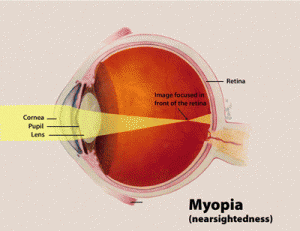Myopia is also called nearsightedness or shortsightedness. In simple terms, a person with myopia can not see clearly in the distance but they can see objects clearly that are nearby or a short distance away. Thus the condition is also called near-sight (nearsightedness) or short-sight (shortsightedness).
Small children fairly universally develop good vision. When they reach their school years, some of them develop blurred distance vision as their eyes become myopic. Here are some random facts to get you thinking: Myopic parents have more myopic children than non-myopic parents. People in urban environments have more myopia than rural or primitive societies. The amount of reading or near work a person does is not predictive of whether they will become myopic. Native Eskimo populations, spending many months of the year in small enclosed structures, working with tools and other close vision tasks, do not develop myopia. However, their children develop high rates of myopia when sent to schools. The eye determines where correct focus is located while it is growing by the clarity of peripheral (side) vision, not central vision. People who spend more time outdoors, even if they have myopic parents and even if they read a lot, are less likely to become myopic. As you can see, the story is not straightforward. If you were expecting “your genes determine if you become nearsighted and reading makes it worse” then now is the time to learn the real story.
Source: wikipedia.org
Myopia is also called nearsightedness or shortsightedness. In simple terms, a person with myopia can not see clearly in the distance but they can see objects clearly that are nearby or a short distance away. Thus the condition is also called near-sight (nearsightedness) or short-sight (shortsightedness).
Small children fairly universally develop good vision. When they reach their school years, some of them develop blurred distance vision as their eyes become myopic. Here are some random facts to get you thinking: Myopic parents have more myopic children than non-myopic parents. People in urban environments have more myopia than rural or primitive societies. The amount of reading or near work a person does is not predictive of whether they will become myopic. Native Eskimo populations, spending many months of the year in small enclosed structures, working with tools and other close vision tasks, do not develop myopia. However, their children develop high rates of myopia when sent to schools. The eye determines where correct focus is located while it is growing by the clarity of peripheral (side) vision, not central vision. People who spend more time outdoors, even if they have myopic parents and even if they read a lot, are less likely to become myopic. As you can see, the story is not straightforward. If you were expecting “your genes determine if you become nearsighted and reading makes it worse” then now is the time to learn the real story.
Research labs around the world, multiple clinical trials and thousands of patients willing to participate are piecing together the story of why myopia develops and thus how it and the eye might be controlled. The work continues but it has reached a stage where the results can not be ignored. It is time to put what has been learned into clinical practice and start to bring this run-away phenomena under control. The clarity of vision of hundreds of millions of people is at stake. It is truly an exciting time for both patients and doctors.

Source: www.allaboutvision.com

